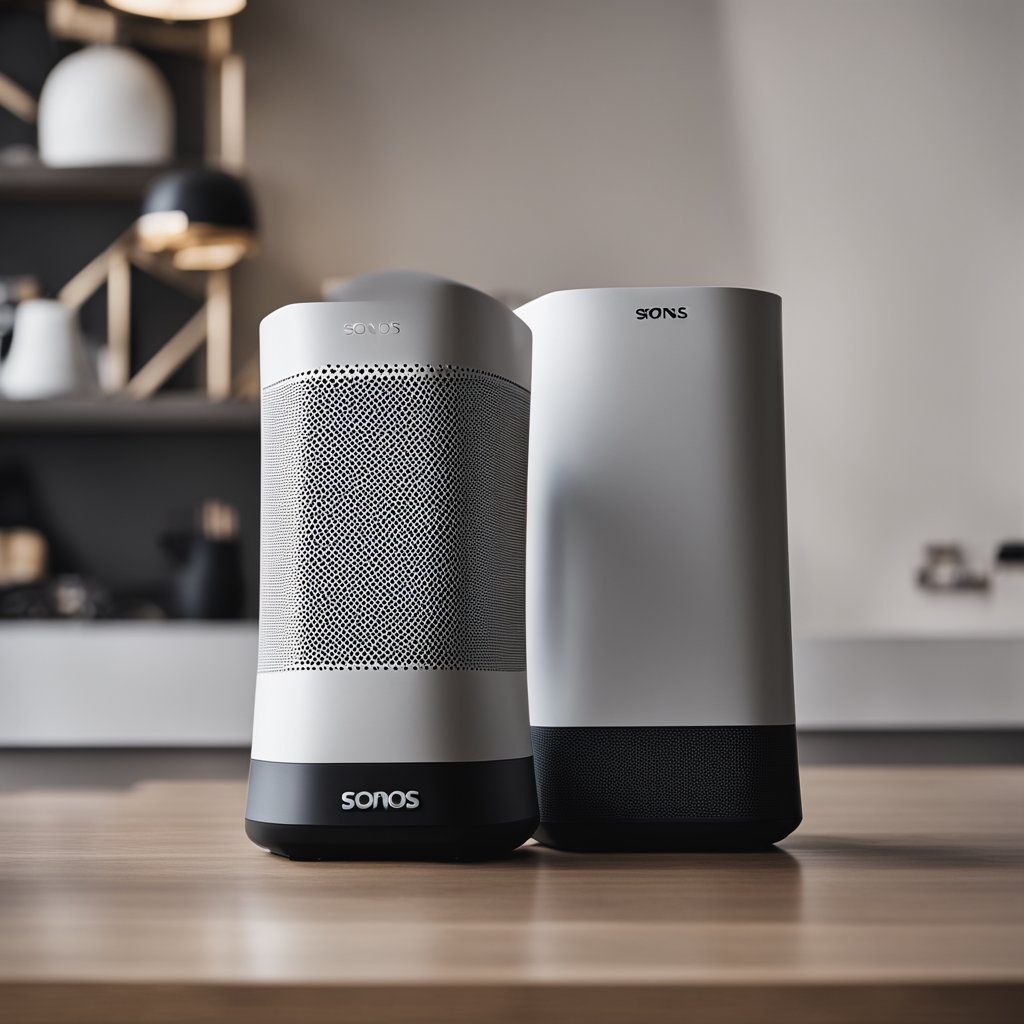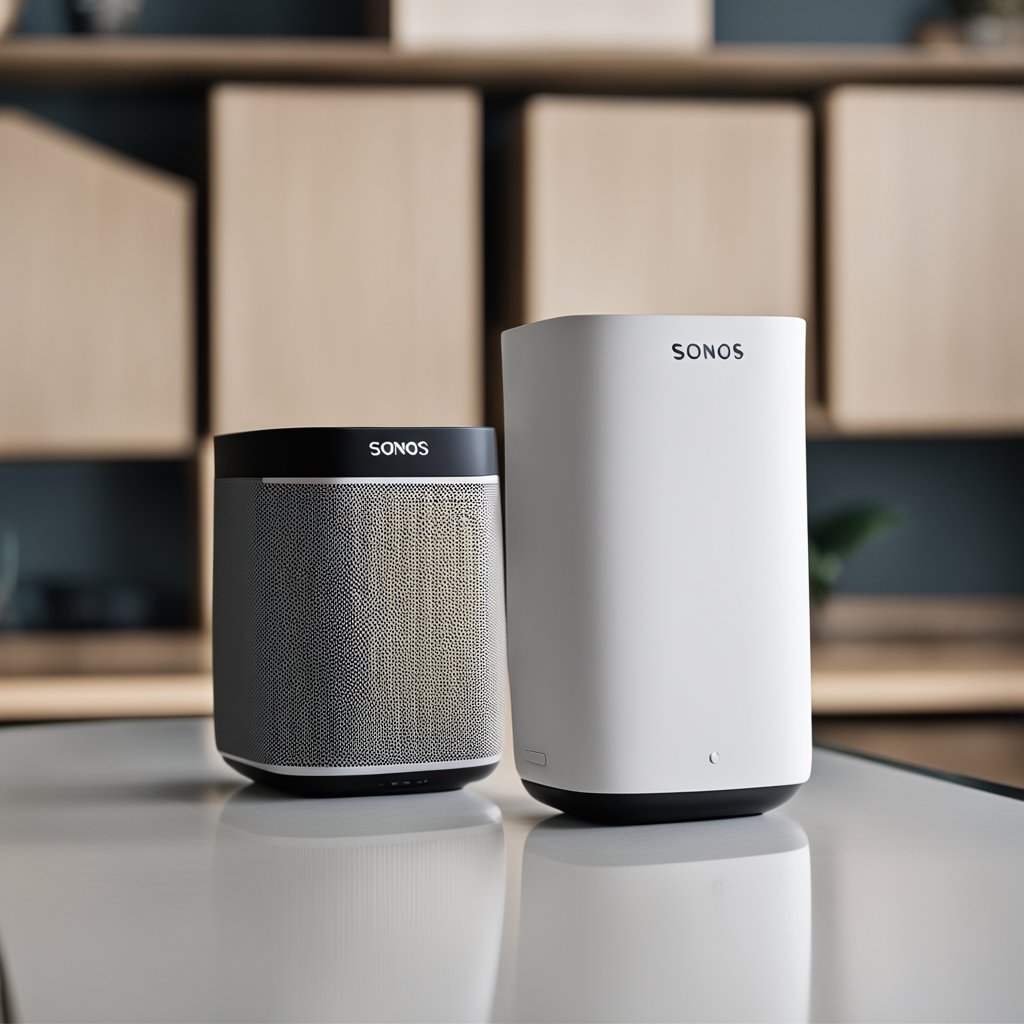I find that choosing between the Sonos One and the Sonos One SL can be a subtle affair as both speakers offer the premium audio experience that Sonos is known for. The Sonos One (Gen 2) and the Sonos One SL share nearly identical designs and acoustic hardware, making them both excellent choices for those looking to enhance their home audio setup with rich and room-filling sound.

The primary difference I note between the two lies in smart capabilities. The Sonos One includes a built-in microphone array which enables voice control through Amazon Alexa or Google Assistant, whereas the Sonos One SL lacks these microphones, rendering it purely as a speaker without smart features. This difference is an essential consideration for consumers who are deciding between voice controlled convenience and a more traditional speaker experience.
Regarding budget, potential buyers should be aware that the Sonos One usually carries a slightly higher price tag due to its smart functionality. For those not inclined to use voice assistants, the Sonos One SL presents a more cost-effective solution. Both speakers support Sonos’ multi-room audio setup and can be integrated seamlessly with other Sonos products to create a cohesive home sound system.
Design and Build Quality

When evaluating the Sonos One and Sonos One SL, I notice that their design and build quality are remarkably similar, offering robust construction and minimalist aesthetics.
Appearance: Black and White Variants
The Sonos One and Sonos One SL both come in two classic color choices: black and white. This allows them to seamlessly integrate into a wide range of home decor styles. Each model sports a sophisticated matte finish paired with a durable metal grille, which is not only pleasing to the eye but also feels premium to the touch.
Size and Portability
Concerning size, both speakers possess a modest footprint, with identical measurements of 6.36 x 4.69 x 4.69 inches. Their compact dimensions ensure they can fit into small spaces with ease, enabling versatile placement options throughout the home.
| Aspect | Sonos One | Sonos One SL |
|---|---|---|
| Dimensions | 6.36 x 4.69 x 4.69 inches | 6.36 x 4.69 x 4.69 inches |
| Weight | 1.85 lbs | 1.85 lbs |
| Color Variants | Black, White | Black, White |
| Build Material | Matte Plastic, Metal Grille | Matte Plastic, Metal Grille |
Their identical size and weight also contribute to their portability, making it convenient for me to move the speakers from room to room if needed, without any hassle.
Core Features and Functionality
In comparing the Sonos One to the Sonos One SL, I’ll focus on how their core features and functionalities align with or diverge from each other, particularly in voice assistant integration, connectivity options, and sound customization capabilities.
Voice Assistant Integration
The Sonos One (Gen 2) comes equipped with a built-in microphone that supports popular voice assistants like Amazon Alexa and Google Assistant. This integration allows users to control the speaker, other smart devices, and access streaming services with voice commands. On the other hand, the Sonos One SL lacks this feature, targeting users who prefer a speaker without any listening capabilities for increased privacy.
Connectivity Options
Both speakers support Wi-Fi to stream directly from services like Spotify, Apple Music, and Tidal via the Sonos App. For Apple users, AirPlay 2 enables streaming from iOS devices. Notably, neither speaker natively supports Bluetooth connectivity, unlike other Sonos products such as the Move and Roam. Both models include an Ethernet port, offering a wired network connection option for potentially more stable streaming.
Sound Customization
One should not overlook the emphasis Sonos places on sound quality and customization. Both speakers utilize the same audio hardware, featuring a mid-woofer and tweeter for a rich sound and clear vocals, and can be tuned using Sonos’ Trueplay technology, which adapts the speaker’s output to the acoustics of the room (note that this feature requires an iOS device). The Sonos App allows users to adjust the EQ settings, including bass and treble, to tailor the listening experience to their preference. Additionally, if two of the same model are owned, they can be configured as a stereo pair to enhance the stereo sound effect.
While both speakers share many similarities in sound quality and connectivity, the choice between them often hinges on whether one requires voice assistant functionality.
Setup and Ease of Use
Setting up both the Sonos One and Sonos One SL is streamlined and user-friendly, reflecting Sonos’ commitment to accessibility in getting their products ready for use.
Initial Speaker Setup
For my initial setup, I find both speakers require similar steps to get started. Sonos facilitates setup through the Sonos S2 app, which I can easily download on my smartphone or tablet. After installing, it’s as simple as plugging in the speaker and following the app’s instructions. The app guides me through connecting to my Wi-Fi network and linking my streaming services for seamless music playback. Both Sonos One and One SL support a variety of streaming options, making it convenient for me to enjoy my music regardless of the platform I use.
Smart Home Integration
As for integrating with smart home systems, there’s a noticeable difference. My Sonos One comes with a built-in microphone that allows me to directly access smart assistants like Amazon Alexa or Google Assistant. I appreciate the convenience of voice commands for hands-free control. In contrast, my Sonos One SL doesn’t have this feature; it’s designed to complement an existing Sonos system, functioning perfectly as a secondary speaker without voice assistant capabilities. Multi-room audio set-ups are straightforward with both models; they integrate effortlessly with other Sonos products, allowing me to manage audio across different rooms through the Sonos app.
Price and Value
In comparing the Sonos One and One SL, I consider not only the initial cost but also the overall value based on features and potential longevity.
Cost Comparison
- Sonos One (Gen 2): Priced at $219
- Sonos One SL: Priced at $199
The Sonos One, equipped with voice assistant capabilities, commands a $20 premium over the Sonos One SL. Both speakers share the same high-quality audio components and design, excluding the microphone and voice assistant functionality in the SL.
Long-term Value
When assessing long-term value, the extra cost of the Sonos One might be justified for users seeking voice control integration with Alexa or Google Assistant. The integrated microphone in the Sonos One also prepares it for potential future smart features that leverage voice commands. On the other hand, the Sonos One SL could provide better value for those who prioritize straightforward high-fidelity audio without the need for smart features or already have another device to manage voice interactions.
Frequently Asked Questions
In this section, I cover some common inquiries regarding the Sonos One and the Sonos One SL to clarify their differences and compatibility.
What are the main differences in audio quality between the Sonos One and the Sonos One SL?
Both the Sonos One and the Sonos One SL deliver the same high-quality audio with a woofer and tweeter combination powered by class D amplifiers. There is no difference in audio quality between the two speakers.
How do the specifications compare between the Sonos One and the Sonos One SL?
The Sonos One and One SL are identical in size and use the same internal speakers. Both measure at 6.36 × 4.69 × 4.69 inches and have the same weight. The main specification difference is that the Sonos One includes a built-in microphone for voice assistant support while the Sonos One SL does not.
Is there a difference in functionality between the Sonos One Gen 2 and the Sonos One SL?
Yes, the Sonos One Gen 2 offers voice assistant support due to its built-in microphone, allowing users to utilize Alexa and Google Assistant. The Sonos One SL lacks this feature and serves as a more straightforward wireless speaker without voice control.
What does the ‘SL’ designation on the Sonos One SL stand for?
The ‘SL’ in Sonos One SL signifies ‘Speechless,’ indicating that the speaker lacks the voice assistant and microphone capabilities present in the Sonos One.
Can the Sonos One and the Sonos One SL be paired together for stereo sound?
Yes, the Sonos One and One SL can be paired for stereo sound. Despite the Sonos One’s additional voice assistant features, both speakers are designed to work seamlessly together to enhance the audio experience.
Has the Sonos One been discontinued in favor of the Sonos One SL?
No, the Sonos One has not been discontinued in favor of the Sonos One SL. As of my knowledge cutoff in early 2023, both models were available, with the Sonos One maintaining its position as the smart speaker with voice control while the Sonos One SL catered to users who preferred a speaker without these features.
Leave a Reply